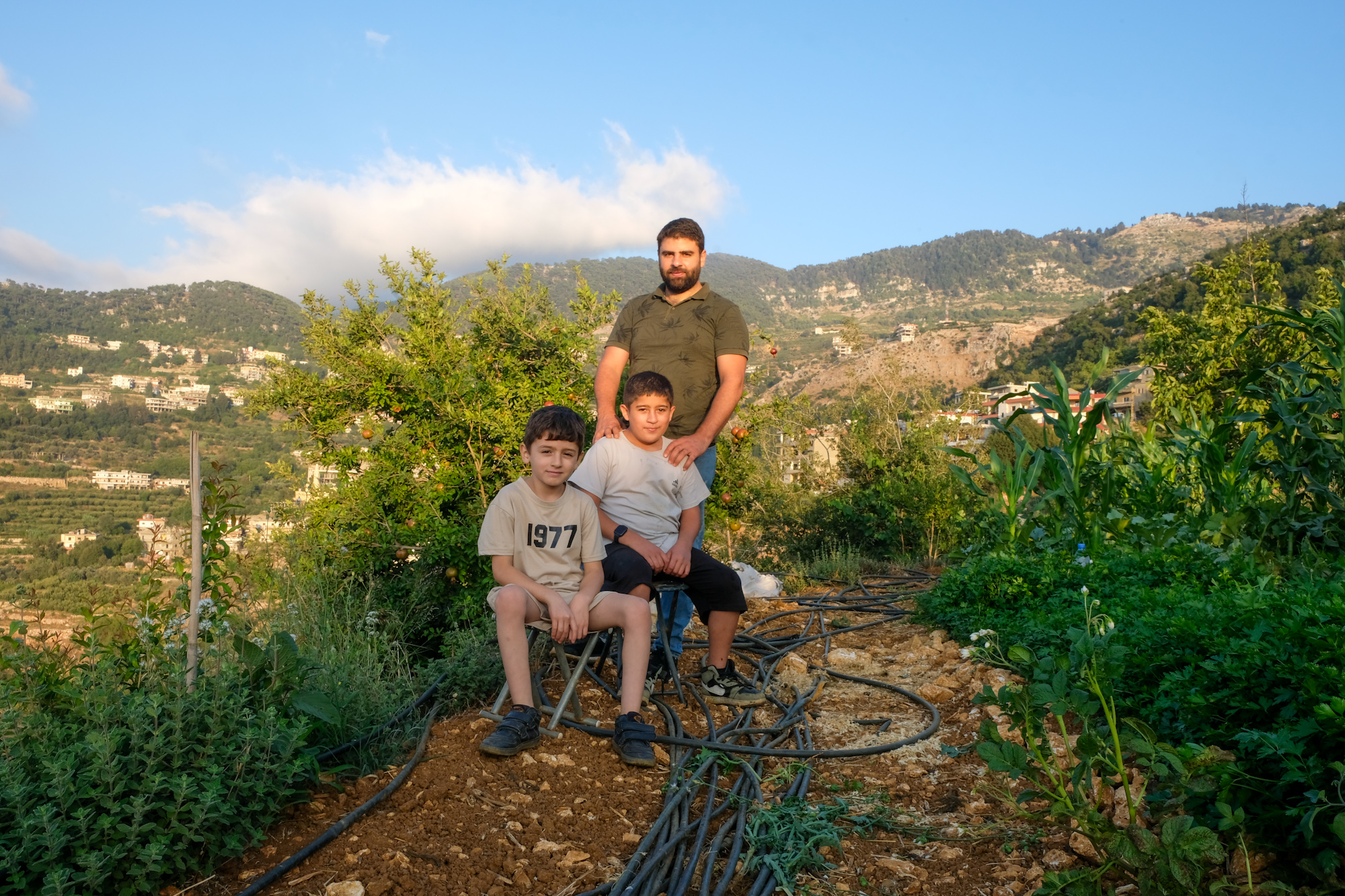LOUBIEH IN THE NORTH
TEXT: JENNY GUSTAFSSON
PHOTOS: JENNY GUSTAFSSON
RESEARCH: YARA WARD
EDITS: NISREEN KAJ
Harvesting beans with Ahmad Bahri and his nephews in Akkar
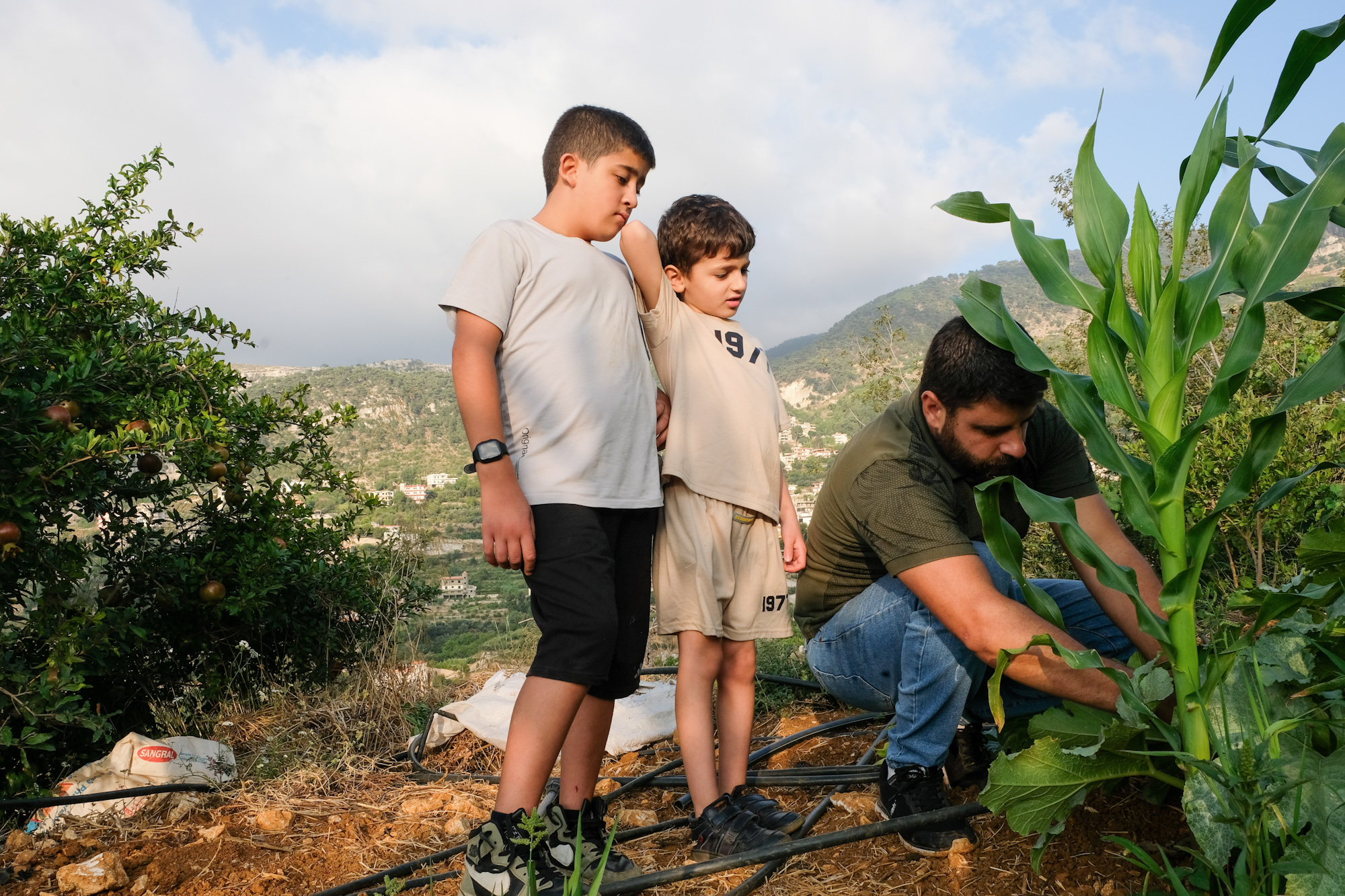
Ahmad with Khoder and Taymm, the sons of his brother and sister, and Akkar al Atiqa in the background
The view from the small piece of land cultivated by Ahmad Bahri, a mechanical engineer and farmer, is grand. His vegetable field stretches all the way to the edge of a mountain overlooking the valley below Akkar al Atiqa, a rural town in the eastern part of Akkar, Lebanon’s northernmost region.
The slopes leading down to the valley are covered in greenery, as many families here grow crops on small plots of hilly land. Ahmad, who was born and raised in Akkar al Atiqa (which means Old Akkar), comes from one of these farming families
“The Bahri family is one of the biggest agricultural families in this region,” he says.
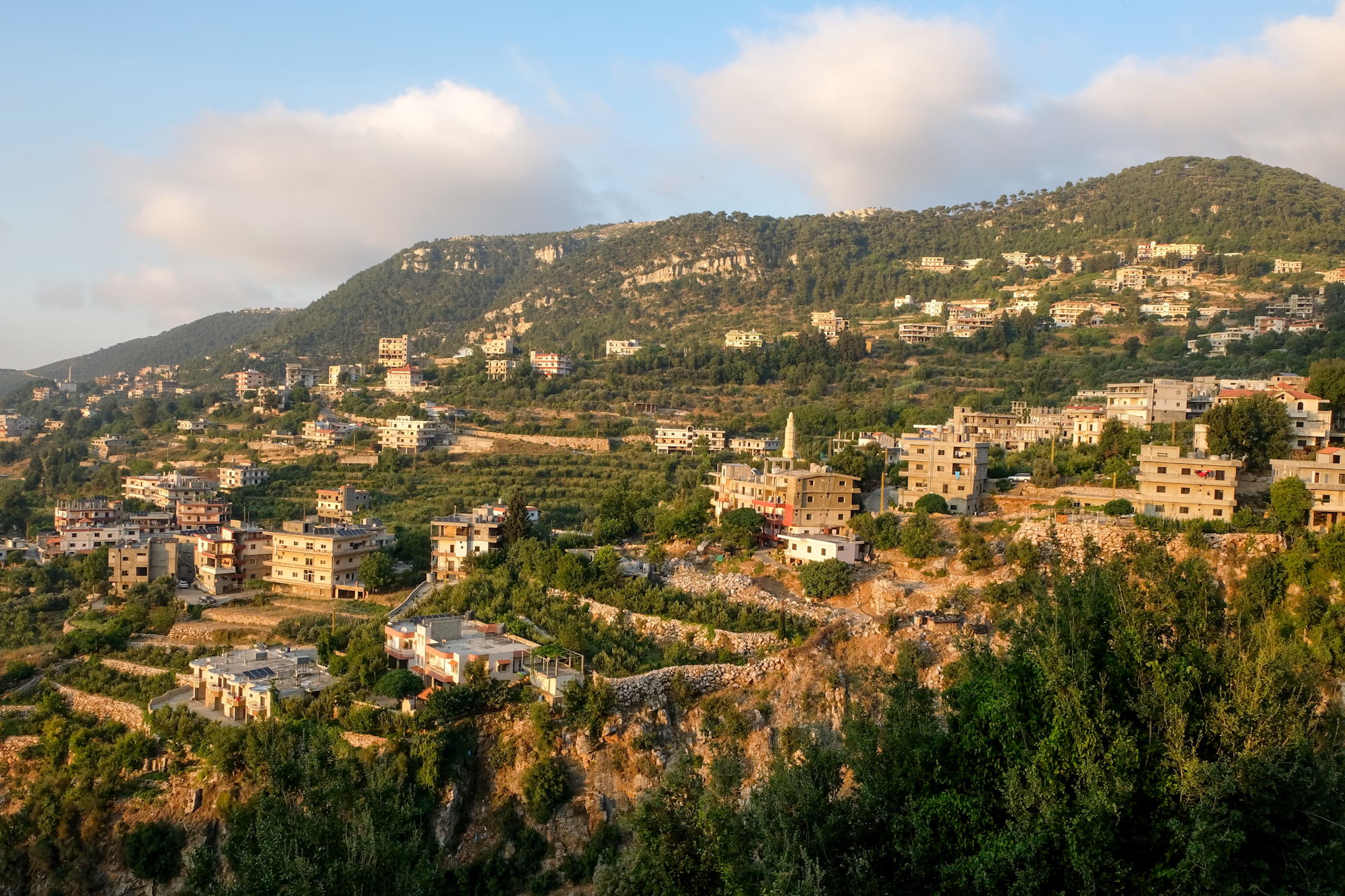
He walks on a small path that runs along the edge of his field, leading from one end to the other.
Following his footsteps are two boys, Taymm and Khoder, the sons of his brother and sister, respectively.
“We’re going to harvest loubieh today, and then we need to remove some of the leaves of the zucchini plants,” Ahmad says as he reaches the far side of the field, directly overlooking the valley.
All along the edge are tall loubieh plants – green beans in pods – climbing up thin sticks planted in the ground. In English, this bean is known as runner bean and belongs to the large legume family Fabaceae (the third largest of all land plant families in the world, after the orchid and aster/sunflower families).
“There are many kinds of loubieh. From research I’ve done, I know about 20 different ones. I brought some seeds back from a trip to Sri Lanka, but haven’t tried planting them here yet,” Ahmad says.
He starts picking the long, flat beans that grow among the leaves, and throws them in black boxes placed on the ground. Taymm and Khoder join him, helping with the harvest. The boxes fill quickly.
Loubieh is a popular bean in Akkar and other parts of Lebanon. Along with other pod beans (also known as common beans), it made its way to the Mediterranean from the Americas, where it grew wild before being domesticated, researchers believe, some 8,000 years ago. In the 1500s, after being brought over by Europeans who colonized the Americas, loubieh started growing along the Mediterranean shores.
The beans became a staple in the region, more quickly than some other foods from the Americas, such as tomatoes, potatoes, and maize – perhaps because they resembled another bean that had been growing in the Mediterranean for millennia: fava, or foul in Arabic. The fava bean is one of the oldest domesticated legumes in the world, and was first foraged and later cultivated in what is today Lebanon, Syria, Palestine, Turkey, and Iraq.
Ahmad has around 1,000 loubieh plants on his land. They are of two different kinds: one that is flatter called “loubieh aarida,” and one that has larger seeds. Ahmad calls it “American loubieh.”
Loubieh is one of many bean varieties harvested and eaten with their pods, including soybeans, haricots verts, fava beans, sugar snap peas, and snake beans

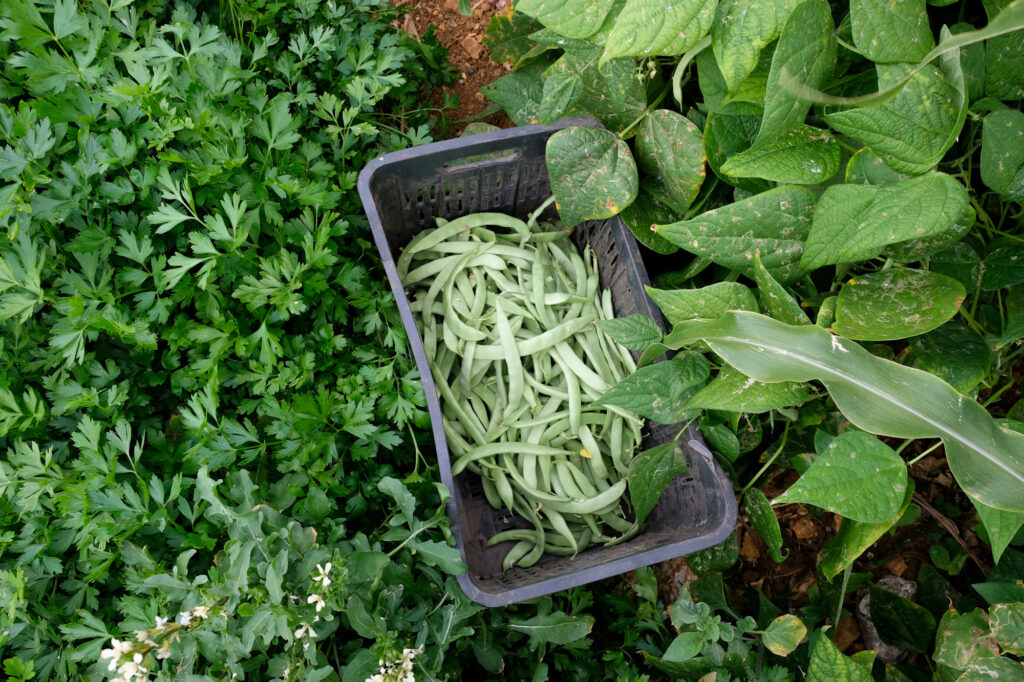

“I like American loubieh best. We have a nice way of cooking them with zucchini, chili, and tomato,” Ahmad says.
The most well-known loubieh dish in Lebanon is loubieh bi zeit – runner beans (loubieh aarida) cooked with olive oil, onion, and tomato.
Many dishes are cooked in this classic manner (with or without tomato), with the words bi zeit, “with oil,” simply added to the name of a vegetable: bamieh (okra), hindbeh (dandelion greens), or foul akhdar (fresh fava beans in their pod).
Food based on legumes and pulses is central to Mediterranean cooking. In these diets, beans and lentils are the main source of protein – the result of a culinary and agricultural history where legumes were always affordable and available. They were easy to grow in the region’s sunny climate and could be stored for long periods of time. Legumes also have a special ability to obtain nitrogen from the atmosphere, use it to produce protein in their seeds, and return it to the soil when the plant dies – an important process for areas with nutrient-poor soil.
Ahmad and his nephews have now filled two large boxes with loubieh and have started picking cucumber from plants growing close to the ground, their long green vegetables hidden beneath the leaves. The boys like to spend time here, Ahmad says, and often join him when they are free. They prefer planting to harvesting.
“Can you see these nice cucumbers? Every day I harvest four to five kilos. My mom is very happy with that,” Ahmad says.
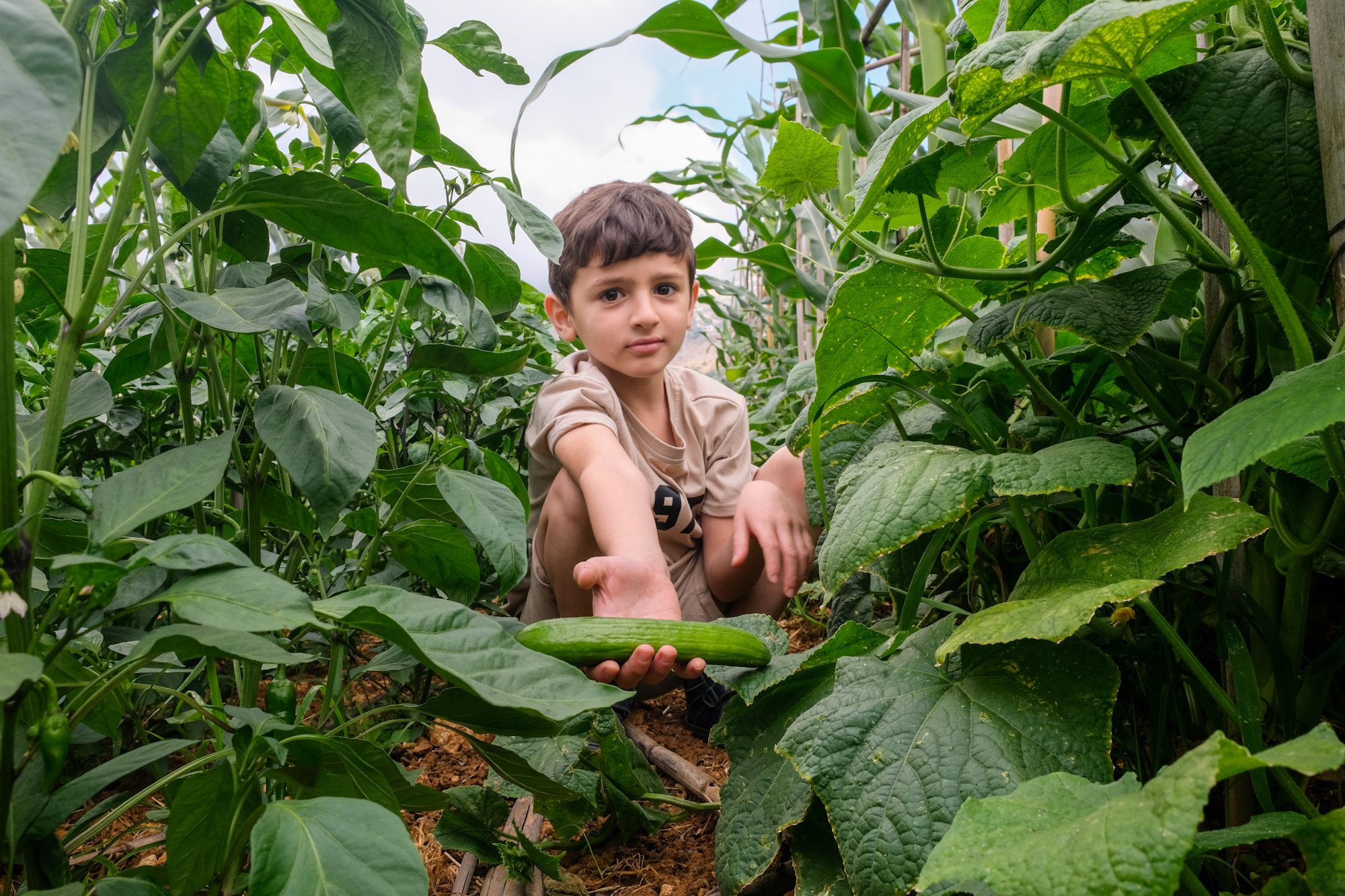


He has been using organic methods to cultivate this land for over four years now. It started during the pandemic and Lebanon’s economic crisis, when Ahmad first had to shift to online work and then got fewer and fewer job opportunities. He began focusing more on agriculture, and now does part-time farming, part-time engineering work online.
“I grow crops for our own needs on this land. Whenever we get more than what we can eat, I either give it to our neighbors or sell the produce,” he says.
The family also owns another piece of land below his vegetable field, where they use chemical substances. They sell the produce to shops and markets. Ahmad would like to transition it to organic production as well, but that would require a lot of work.
“Organic produce barely sells in the market. And I would need maybe five or six people to work with me if I did that,” he says.
He points to zucchini lying on the ground; they are much bigger than normal and have been left there for a reason. This is how Ahmad gets seeds for next year: he lets some vegetables grow overly large, then extracts their seeds.
“I do the same with my cucumber. They need to ripen and turn yellow first, then I can take out the seeds,” he says.
Ahmad shows the “American loubieh” he grows, which has larger beans than other varieties
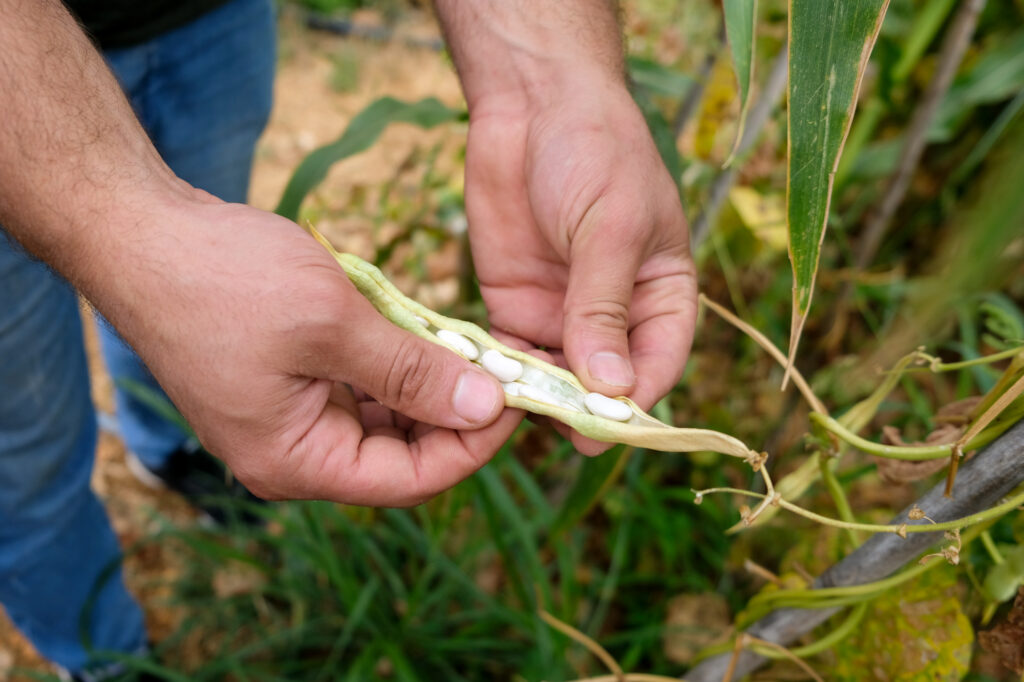

Ahmad, a mechanical engineer, turned to agriculture during the pandemic and economic crisis in Lebanon
Ahmad has planted many of his vegetables this way, with seeds from previous years’ yields. Using local seeds is central to the concept of seed sovereignty, where farmers and growers maintain control of their harvests.
La Via Campesina, an international farmers’ movement, sees seed sovereignty as central to reclaiming biodiversity as a common and public good. Farmers should be able to save, breed, and exchange seeds without depending on large international suppliers.
This has been the case throughout history, all over the world. Growers would save seeds from the plants that did best for them, and exchange them locally and regionally. In this way, a kind of transnational gene bank was created, which maintained the diversity of global crops.
But things changed with the onset of the Green Revolution in the 1960s, which sought to make global agriculture efficient through the introduction of fertilizers, pesticides, and high-yielding crops. Since then, farmers have been pushed towards using more hybrid or GMO seeds, both of which often require the use of fertilizers, chemicals, and water to produce yields. These seeds are marketed as “improved,” but in reality, they lower biodiversity and place farmers in dependency on global seed providers.
The global seed market is now so concentrated that four companies – Germany’s Bayer (which acquired Monsanto in 2018) and BASF, China’s Syngenta Group, and Corteva in the United States – control 62 percent of it. Economists typically consider a four-firm concentration ratio of 40 percent or more to be an oligopoly.
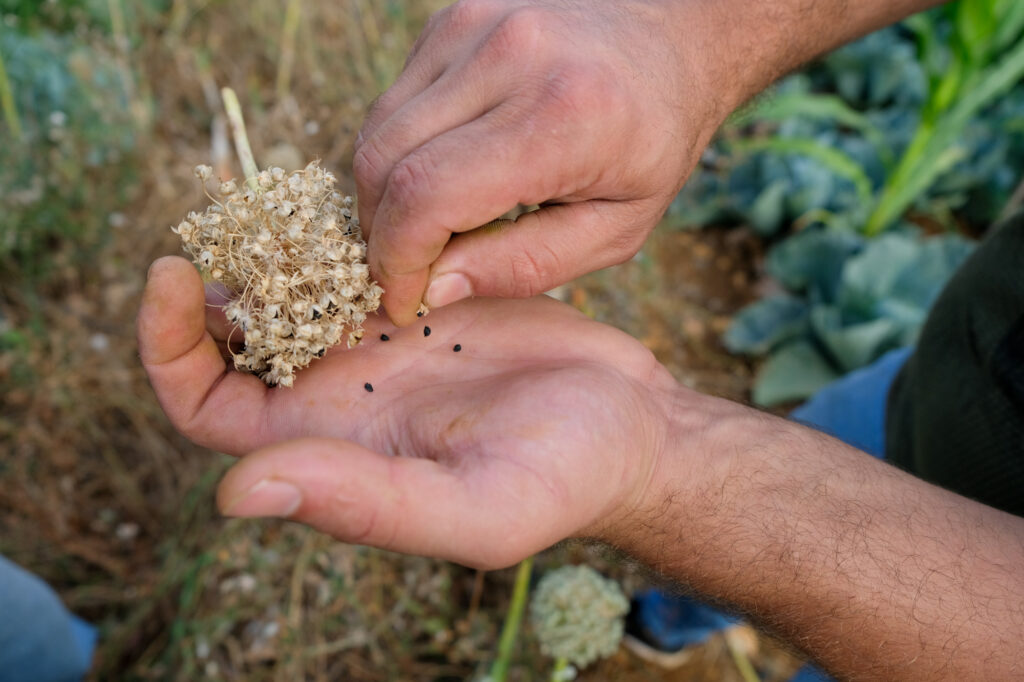
Tiny seeds from the onion plant, which Ahmad will save to plant next year
In Akkar al Atiqa, Ahmad picks up a flowering onion plant from the ground. As he opens its tiny pods with his fingers, small black seeds fall into his palm. Seeds like these, known as heirloom seeds, are more nutritionally dense and resilient to the consequences of climate change, because they form part of a diverse gene pool.
“The corn seeds I use are the same variety my grandfather used. Even my great-grandfather used those seeds,” Ahmad says.
“I call the seeds bahri, after our family name, he says.”
Ahmad has 200 kilograms of corn seeds in storage, ready for the next planting season. He also sells seeds, whenever he has more than what he needs, at a local agricultural shop.
“I sell zucchini seeds that I developed by hand seven years ago. I’m still perfecting them, but the yield is good. People buy them because they believe they are more resistant to diseases,” Ahmad says.
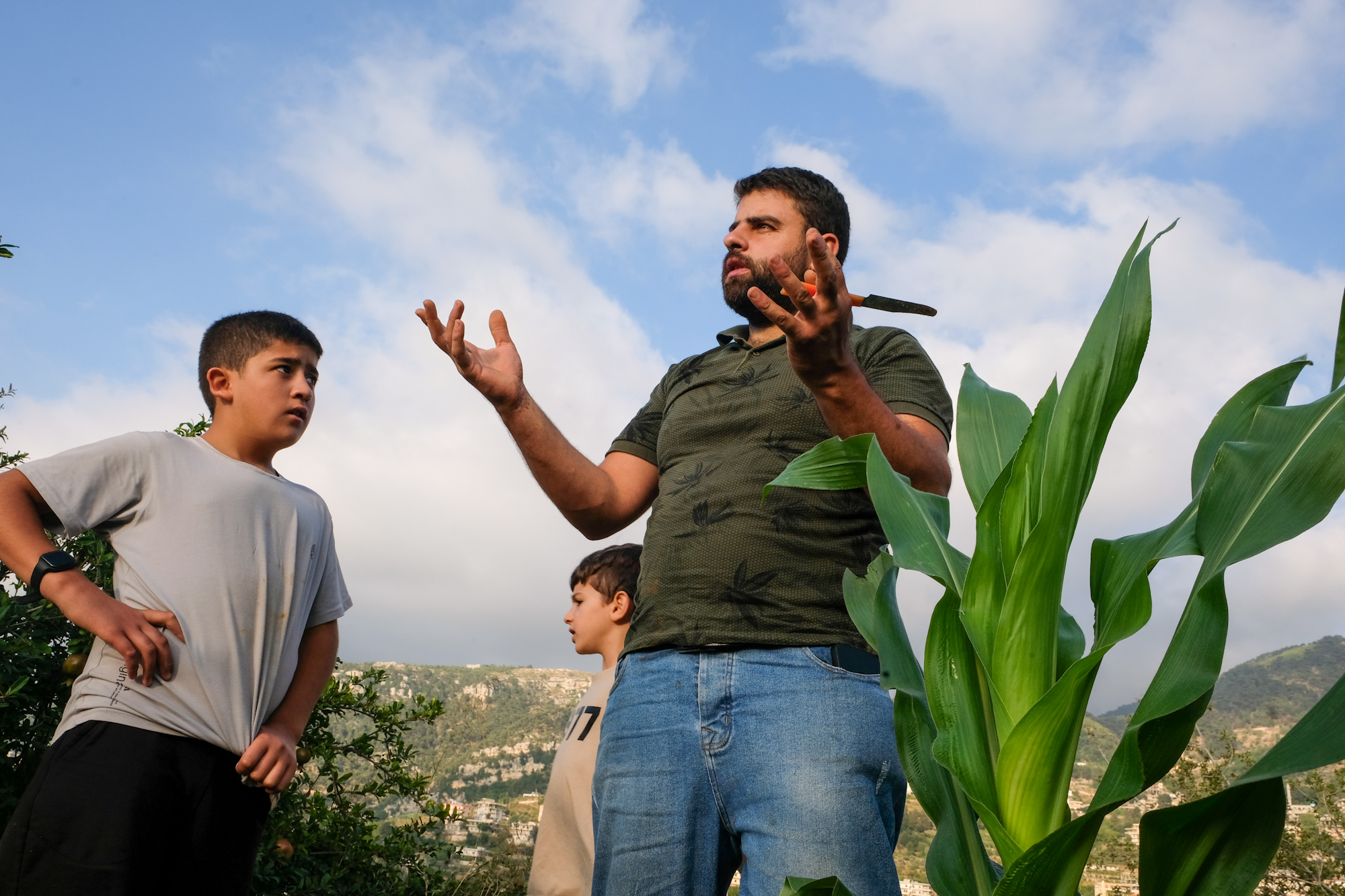
Around 90 percent of the seeds he uses come from his own crops. For this, he relies on knowledge passed down through generations in his family, he says, as well as new techniques from YouTube and Instagram. Historically, farmers in Lebanon, Syria, and the surrounding region saved and exchanged seeds in a number of ways. They shared them through informal community networks and brought them to seasonal markets and harvest festivals (where not only seeds but also knowledge was exchanged). Traders traveling from village to village would also carry seeds, and farmers would bring them to exchange at religious gatherings.
This ensured that farmers had access to seeds that were well-suited to the climate, and resilient to droughts, heat, and local soil conditions.
Seed sovereignty takes on an added importance in times of war and conflict. Buzuruna Juzuruna, a farm in the Bekaa Valley, emerged from an initiative to send seeds from Lebanon to the Yarmouk area in Damascus, a Palestinian camp built in the city, as it was under siege during the early days of the war in Syria. People with family members in Yarmouk realized that access to seeds was a matter of survival for them.
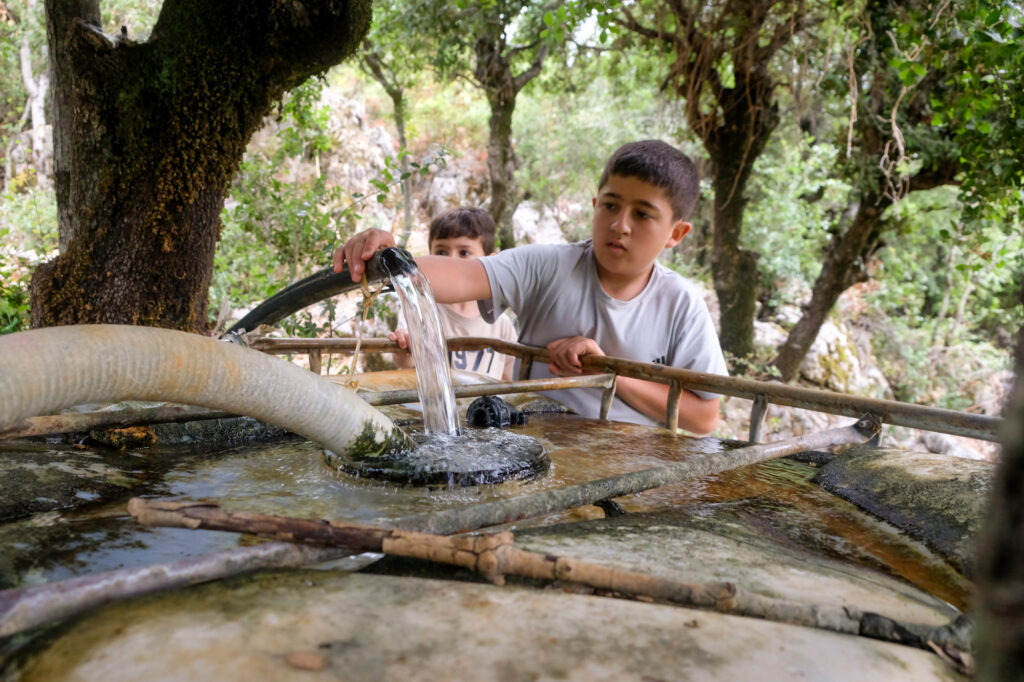
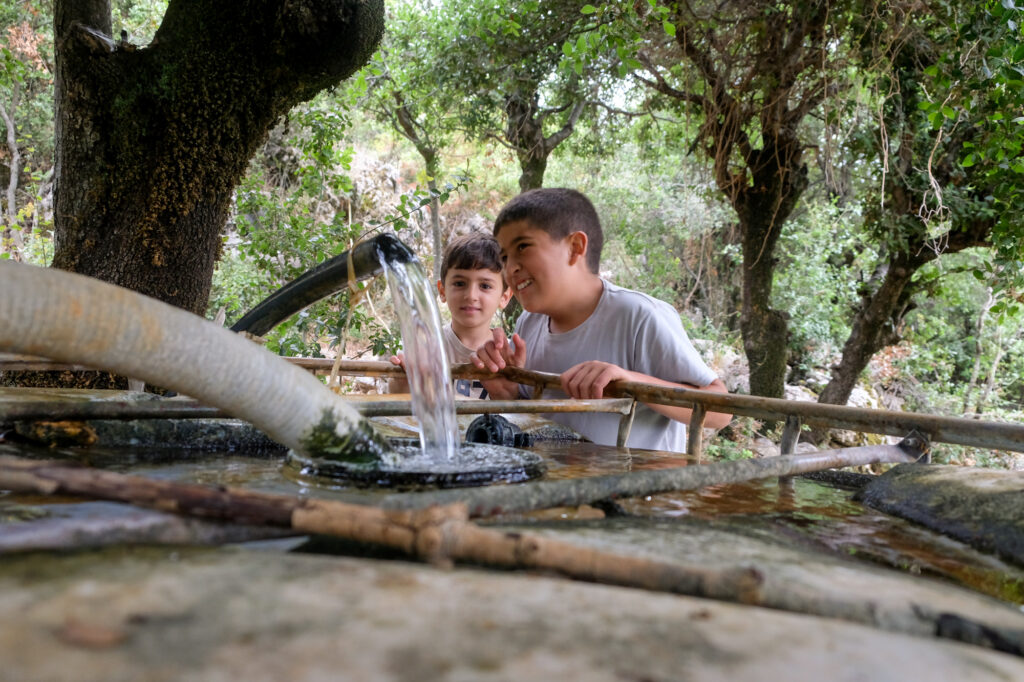
Taymm and Khoder help manage the pump used to irrigate the land

Today, while farmers globally use more commercial seeds than before, the vast majority still plants local seeds. Farmer-controlled networks account for an estimated 80-90 percent of all seeds used globally, according to the Food Barons 2022 study. In Lebanon, several initiatives have been launched in recent years. Buzuruna Juzuruna and four other farms have a network called Hobob, and the AgriMovement gives free seeds through their Seed in a Box initiative. Nohye el Ard works on preserving and exchanging heirloom seeds in Saida. And earlier this fall, a regional alliance was formed between farmers in Iraq, Iran, Egypt, Lebanon, Syria, and Palestine to strengthen ties across the borders.
In Akkar al Atiqa, Ahmad and his nephews feed chickens living next to the land. The view over the valley extends in several directions. Right below the land are the ruins of what was once a fort, dating back to the Fatimid era and captured by both the Crusaders and the Mamluk commander Baybars.
Ahmad recalls a story about the fort: part of it was destroyed by Emir Fakhreddine, who had the stones transported all the way to Beiteddine to build the castle there.

The view from Ahmad’s land in Akkar al Atiqa
When the chickens have been fed, Ahmad has only one more thing to do: take the boxes of vegetables to his car, then leave the land as is until he returns the next day.
“I love to see the results in the fields. It’s impossible to describe the feeling. Especially when I know that the seeds are mine and I harvested the crops myself. It’s like raising children,” he says.
